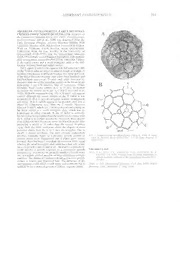
Aberrant Pandanocrinus, Early Devonian crinoid from north Queensland PDF
Preview Aberrant Pandanocrinus, Early Devonian crinoid from north Queensland
ABERRANTPANDANOCRINUS 351 ABERRANT PANDANOCRINUS,EARLY DEVONIAN C'RINOID FROM NORTH QUEENSLAND.Memoirs of theQueenslandMuseum 43(1): 351. 1999:-Pandanocnims martinswellensis Jell et al., 1988 was described from the % Early Devonian (Pragian; sulcatus Biozone) Martins Well I.iinestoneMemberoftheShielsCreekFormationalMarlins . Well on Pandanus Creek Station, north Queensland. Collections from the type locality in the University of Queensland (UQL3579) and the Queensland Museum (QMI.550)includeseveralhundredindividualswith uniform platearrangementexceptforQMF25736, whichhas7plates in the radial circlet and a small triangular plate at the D-E inlerraybetween basal andradial circlets. BB3,equal,2with3sidesagainstRR,3rdwith4or5.BB circlet7-sided;sidesarenoteveneitherinlengthorinangleof meeting. Orientation is difficult because free amis and most oftheuppertheeaaremissing,onlyafewfixedbrachialsand interbraehials preserved. 7-sided anal plate bisected by diameterwithoneofthe interplalesuturesinthebasal circlet indicating A ray-CD inlerray line of symmetry. Other interplale basal circlet sutures in C & D rays; in normal specimens the sutures are in the A. C and E rays (Jell el al.. 1988). Withthisorientation(Fig. 1B)A.BandCraysappear normal although the upper margin of the B radial is not symmetrical. D & E rays are irregular in plate arrangement and shape. D & E radials appearto be divided, each into 2 plates of comparable size; thus Ihe 7 radials. Between adjacent DandEradials(i.e. 1 fromeachpair)andrestingon the basal circlet is a small triangular plate which has no homologue in other crinoids. If the D radial is correctly interpretedasbeing2platesthentheanalisnotincontactwith the Cradial asinnormal specimens. Moreover,thereappear tobe2platesintheCDinterrayinthe Istbrachialcirclet:thus producing a circlet of 11 rather than the normal 10 plates. Apart from the more numerous plates the shapes ofmost posterior plates from the C to E rays are irregular. This is clearly a unique specimen. The most obvious explanation sienvveorlavlespltartaeusmawteirceinfjruargymeasntaedjuavenndil2e;plgartoewsthgrceewntrwehseroe\' FIvQG.iMeFwI25Poaf7n3adb6aenrorcarntintuhsecmaarQtiMnFs2we5l7l3e6ns,is J1el5l etB.al.p.la1t9e88d.iaAg.rabmasaolf formerlytherehadbeen I.Inradials.divisionwasfairlyequal whereas thesmall triangularplatemust havehadonlya tiny pieceofgrowthcentretostartitoff. Alternativeexplanations could involve a growth response to a constricted growth LiteratureCited pmsciouetsnteita,trtiieinosonnai.(tsei'.grHgh.eit,emloicynthpeaaanccacrkneeedvodifcdmei1esommrau,idtsgoasitwevideoonnhftedlhriaeevr.ngieudTimhcnbregien4rionoiofrdflsmuf)ooesonrsrceielagssoraifotnwtgtthlhheee JELL,Te3Pa5A.s5LtA-eE4r.N0n2TJAu,EsLtJLr.a.Al.iaJ.1.S9.MS,8e.mJoCOirHrinsNoSoifdOstNh.ferQouBm.eDeD.ne.svloaJnnvidainMAWulSsimOeeNus.mton2Re5.s(2o&).f surroundings couldaffectoverall shapeandsymmetrybutis Peter A. Jell. Queensland Museum, P.O. Box 3300. South unlikelytohaveinducedgrowth ofentirelyseparateplates. Brisbane4101,Australia; J"May1999.
